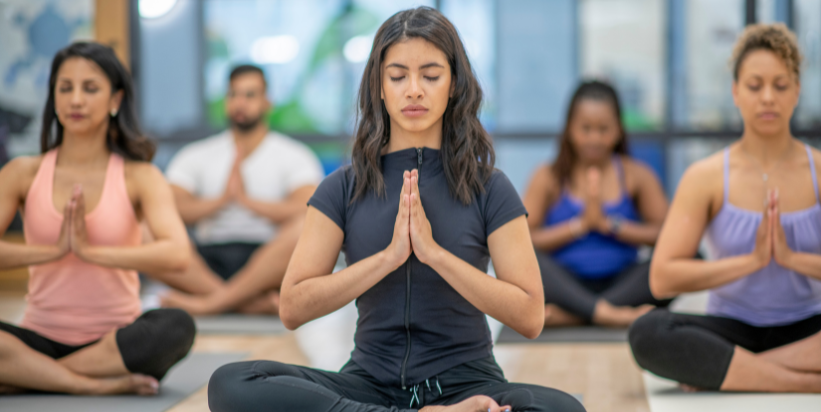Yoga and Christianity: How is Christ-Centered Yoga Different?
Do yoga and Christianity go together? Recently, I was confronted (again) with the controversy surrounding yoga and Christianity when two public figures, people I respect and admire, admonished Christians who practice yoga. I was (and am) heartbroken.
While I understand the complexity surrounding yoga’s history and various philosophies, I also know the benefits of yoga. It can offer many skills that are not only permissible but also beneficial for followers of Christ.
In this blog, we’ll explore the relationship between yoga and Christianity, what makes Christ-centered yoga distinct, and how to practice in a way that avoids syncretism and honors God’s command to have no other gods.
Is Yoga Against Christianity?
Yoga is not “against” Christianity, or any religion for that matter. Yoga is not a religion but a way of life, a state of being, and a practice that includes physical movement, breathwork, and meditation.
Originating within the spiritual traditions of Southeast Asia, yoga itself has evolved over time. It is now practiced by people from many different cultures, beliefs, and backgrounds.
While some Christians are concerned about yoga’s spiritual roots, it’s important to recognize that yoga, especially in its modern forms, can be practiced in a variety of ways. It is not inherently in conflict with Christian faith.
By itself, yoga does not require allegiance to any religion or deity, and many people engage with it for its physical, mental, and emotional benefits, regardless of their spiritual background.
At the same time, yoga has deep roots in the spiritual traditions of Southeast Asia, and for many, it remains a sacred practice. Because of this, concerns about cultural appropriation are valid, especially when yoga is removed from its context, commercialized, or repackaged without acknowledgment of its origins.
For Christians who choose to practice yoga, approaching it with humility, careful study, discernment, and respect is essential. This means learning about its history, being mindful of cultural sensitivity, and maintaining a heart posture that keeps Jesus at the center and honors God above all else.
Can Christians Redeem Yoga?
Is yoga a sin? Can Christians redeem yoga? These are real and important questions, and Christians have different perspectives. (See Every Woman a Theologian’s post or this post from Pasta and Prayers)
I believe the answer is a resounding YES!
Throughout Christian history, believers have embraced the redemptive power of Jesus to transform and reclaim various aspects of culture, creation, and human experience, living out the truth that in Christ, all things can be made new (2 Corinthians 5:17).
To be clear, this isn’t a modern workaround for justifying yoga.
It’s part of a rich Christian tradition of untangling what has been distorted and restoring it for God’s purposes. Throughout history, Christians have reclaimed, baptized, and transformed cultural practices like turning pagan festivals into Christ-centered celebrations (e.g., think Christmas and Easter).
Christians have also adapted popular pub songs and folk melodies into God honoring worship and praise music (e.g. the song What Child Is This? was adapted by Christians from the popular English folk song Greensleeves.)
That said, this process requires thoughtful engagement, discernment, and humility. It’s not a black-and-white issue, and it shouldn’t be approached casually.
Romans 12:2 urges believers not to conform to the patterns of this world, but to be transformed by the renewing of our minds. This means we are called to wrestle with cultural practices like yoga carefully, studying their origins, examining our motives, and asking how they can be practiced in ways that honor God.
When approached this way, the practice of yoga as a Christian spiritual discipline can become a meaningful avenue for embodied worship, healing, and deeper connection with Christ.
What Makes Christ-Centered Yoga Different
The short answer to this question is that in Christ-centered yoga, Jesus is at the center.
The longer answer is that Christ-centered yoga differs from other types of yoga in its theological foundation, Christian worldview, and spiritual aim.
To explain… Traditionally, yoga, rooted in the spiritual traditions of Southeast Asia, was developed as a pathway to “still” the fluctuations of the mind (as stated in the Yoga Sutras of Patanjali) and prepare the body and spirit for deeper states of meditation.
Stillness has always been a central goal of yoga, offering practitioners a way to detach from distractions, ego, and suffering. In many Eastern philosophies, this stillness is often pursued as a means of dissolving the self or achieving a sense of oneness with an impersonal divine force.
But Christian stillness is different. It is not about losing ourselves, it is about finding our true identity in Christ. Christ-centered yoga honors the embodied practice of stillness, but reorients it theologically.
Rather than leading to emptiness, Christian stillness leads us toward fullness: communion with the living God.
In Christ-centered yoga, stillness leads us toward deeper communion… not disconnection.
In this context, stillness becomes a sacred space where we attune our body, mind, and spirit to the presence of the indwelling God. Rather than seeking nothingness, we seek Someone: the Holy Spirit who lives within us (Romans 8:11), the God who knows us fully and invites us into the Trinitarian relationship.
Christ-centered yoga creates room to remember that we are beloved children, embodied image-bearers of God, and in stillness, we don’t lose ourselves. We find our truest selves anchored in Christ, capable of intimate communion with Him.
How to Practice Yoga From a Christian Perspective
Yoga is a practice that has been embraced across a wide range of worldviews and traditions. At its core, yoga helps us to “gather” our scattered selves, body, mind, and spirit, and awaken to the present moment.
When practiced from a Christian perspective, yoga becomes a way of engaging our whole nephesh, our entire living being, in worship and communion with God. Instead of seeking detachment or emptiness, we make space to be filled with God’s presence.
This is not a self-centered pursuit, but a Christ-centered one, aligning every part of us with the invitation to live fully and abundantly in Him (John 10:10).
Here are some ways to practice yoga from a Christ-centered perspective:
- Honoring your body: Move with intention, honoring your body as a temple of the Holy Spirit (1 Corinthians 6:19) and a vessel for God’s presence.
- Renewing your Mind: Bring your focus to the present moment and meditate on Scripture, truth, and the presence of God (Romans 12:2).
- Awakening to the Spirit: Invite the Holy Spirit to meet you in stillness, offering prayer and worship not just with words but with your whole being.
Christ-centered yoga reminds us to abide in Him (John 15:4). It’s not about striving, but about resting in God’s presence.
As we practice, we’re invited to lay down our burdens and take up the easy yoke of Jesus (Matthew 11:28-30), learning to move through life with grace, rest, and reliance on God.
Yoga becomes not a departure from faith, but a quiet return to it, anchored in breath, presence, and God’s self-giving unconditional love.
Longing for a more embodied faith?
Practice, connect, and cultivate a deeper relationship with God in The Yoga Abbey– your online sanctuary for Christ-centered yoga, meditation, and prayer.
Join today and get instant access to over 1,000 Christ-centered yoga, meditation, and contemplative prayer practices!






